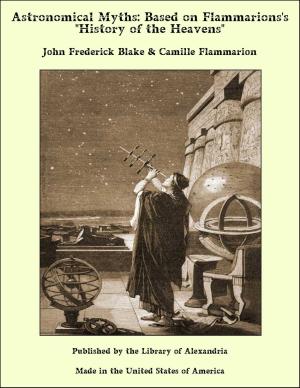Vestiges of the Natural History of Creation
Nonfiction, Religion & Spirituality, New Age, History, Fiction & Literature| Author: | Robert William Chambers | ISBN: | 9781465609120 |
| Publisher: | Library of Alexandria | Publication: | March 8, 2015 |
| Imprint: | Language: | English |
| Author: | Robert William Chambers |
| ISBN: | 9781465609120 |
| Publisher: | Library of Alexandria |
| Publication: | March 8, 2015 |
| Imprint: | |
| Language: | English |
It is familiar knowledge that the earth which we inhabit is a globe of somewhat less than 8000 miles in diameter, being one of a series of eleven which revolve at different distances around the sun, and some of which have satellites in like manner revolving around them. The sun, planets, and satellites, with the less intelligible orbs termed comets, are comprehensively called the solar system, and if we take as the uttermost bounds of this system the orbit of Uranus (though the comets actually have a wider range), we shall find that it occupies a portion of space not less than three thousand six hundred millions of miles in extent. The mind fails to form an exact notion of a portion of space so immense; but some faint idea of it may be obtained from the fact, that, if the swiftest race-horse ever known had begun to traverse it, at full speed, at the time of the birth of Moses, he would only as yet have accomplished half his journey. It has long been concluded amongst astronomers, that the stars, though they only appear to our eyes as brilliant points, are all to be considered as suns, representing so many solar systems, each bearing a general resemblance to our own. The stars have a brilliancy and apparent magnitude which we may safely presume to be in proportion to their actual size and the distance at which they are placed from us. Attempts have been made to ascertain the distance of some of the stars by calculations founded on parallax, it being previously understood that, if a parallax of so much as one second, or the 3600th of a degree, could be ascertained in any one instance, the distance might be assumed in that instance as not less than 19,200 millions of miles! In the case of the most brilliant star, Sirius, even this minute parallax could not be found; from which of course it was to be inferred that the distance of that star is something beyond the vast distance which has been stated. In some others, on which the experiment has been tried, no sensible parallax could be detected; from which the same inference was to be made in their case. But a sensible parallax of about one second has been ascertained in the case of the double star, α α , of the constellation of the Centaur, and one of the third of that amount for the double star, 61 Cygni; which gave reason to presume that the distance of the former might be about twenty thousand millions of miles, and the latter of much greater amount. If we suppose that similar intervals exist between all the stars, we shall readily see that the space occupied by even the comparatively small number visible to the naked eye, must be vast beyond all powers of conception.
It is familiar knowledge that the earth which we inhabit is a globe of somewhat less than 8000 miles in diameter, being one of a series of eleven which revolve at different distances around the sun, and some of which have satellites in like manner revolving around them. The sun, planets, and satellites, with the less intelligible orbs termed comets, are comprehensively called the solar system, and if we take as the uttermost bounds of this system the orbit of Uranus (though the comets actually have a wider range), we shall find that it occupies a portion of space not less than three thousand six hundred millions of miles in extent. The mind fails to form an exact notion of a portion of space so immense; but some faint idea of it may be obtained from the fact, that, if the swiftest race-horse ever known had begun to traverse it, at full speed, at the time of the birth of Moses, he would only as yet have accomplished half his journey. It has long been concluded amongst astronomers, that the stars, though they only appear to our eyes as brilliant points, are all to be considered as suns, representing so many solar systems, each bearing a general resemblance to our own. The stars have a brilliancy and apparent magnitude which we may safely presume to be in proportion to their actual size and the distance at which they are placed from us. Attempts have been made to ascertain the distance of some of the stars by calculations founded on parallax, it being previously understood that, if a parallax of so much as one second, or the 3600th of a degree, could be ascertained in any one instance, the distance might be assumed in that instance as not less than 19,200 millions of miles! In the case of the most brilliant star, Sirius, even this minute parallax could not be found; from which of course it was to be inferred that the distance of that star is something beyond the vast distance which has been stated. In some others, on which the experiment has been tried, no sensible parallax could be detected; from which the same inference was to be made in their case. But a sensible parallax of about one second has been ascertained in the case of the double star, α α , of the constellation of the Centaur, and one of the third of that amount for the double star, 61 Cygni; which gave reason to presume that the distance of the former might be about twenty thousand millions of miles, and the latter of much greater amount. If we suppose that similar intervals exist between all the stars, we shall readily see that the space occupied by even the comparatively small number visible to the naked eye, must be vast beyond all powers of conception.















